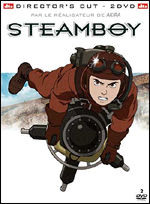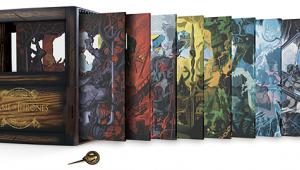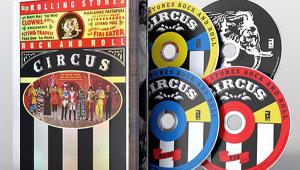Steamboy Director's Cut DVD Gift Set
Directed by Katsuhiro Otomo. Aspect ratio: 1.85:1 (anamorphic). Dolby Digital 5.1 (English, Japanese), Dolby Surround (French, Spanish, Portuguese). 126 minutes. 2004. Sony Pictures Home Entertainment 05503. PG-13. $49.95.
Picture ****
Sound ****
Film ***
I'm a big fan of both traditional and computer animation, but I've never quite warmed up to the unique Japanese animation style known as anime. The plots are often frustratingly convoluted, and the character movements are reminiscent of the jerky, limited animation techniques championed back in the late 1950s and 1960s by the Hanna-Barbera cartoon factory for television shows like The Flintstones and Johnny Quest.
 But despite these problems, anime is frequently far more elaborately drawn than those creaky-looking TV potboilers. In fact, anime can be downright gorgeous in the hands of its best practitioners, compensating in style for what it lacks in fluidity—and then some. The most celebrated of these anime artists is Hayao Miyazaki (Princess Mononoke, Spirited Away, Howl's Moving Castle). Equally renowned, though far less prolific, is Katsuhiro Otomo, whose last major effort, Akira, was a violent affair with one of those wildly intricate anime plots. It may also be the single best-known anime feature ever made.
But despite these problems, anime is frequently far more elaborately drawn than those creaky-looking TV potboilers. In fact, anime can be downright gorgeous in the hands of its best practitioners, compensating in style for what it lacks in fluidity—and then some. The most celebrated of these anime artists is Hayao Miyazaki (Princess Mononoke, Spirited Away, Howl's Moving Castle). Equally renowned, though far less prolific, is Katsuhiro Otomo, whose last major effort, Akira, was a violent affair with one of those wildly intricate anime plots. It may also be the single best-known anime feature ever made.
Steamboy, Otomo's follow-up to Akira, has been 10 years in the making, and one viewing will show you why. It's the most visually stunning animated feature I've ever seen. It doesn't escape entirely from anime's often stilted character movement, but there was so much going on that I rarely noticed. Steamboy also effectively combines both conventional 2D and computer animation. The latter doesn't have the sort of depth you see in a computer-animated feature. It can't, since it has to blend with the 2D drawing. But computer enhancement makes possible the sort of visual feast that 2D alone can never deliver, whether it's showing a scene first defocused then sliding into focus as one of the characters looks through a telescopic device, or the reflections of characters from shards of flying glass. A few flat-looking, hand-drawn static shots were the only jarring elements. You'll know them when you see them.
The surprisingly straightforward story takes place in Victorian England, circa 1866. The Steam family—patriarch Lloyd, his son Eddie, and grandson Ray (the title character)—are engineering geniuses, specializing in the development of steam power. As the plot cuts from a brief introduction in the 1830s to 1866, Lloyd and Eddie have discovered a way to contain steam in a tiny, extremely powerful ball (a not too-subtle metaphor for nuclear power, methinks). By this time, Lloyd and Eddie have become estranged and gone their separate ways, while young Ray lives with his mother and sister.
Neither Lloyd nor Eddie is a black and white caricature, but both have more than a trace of the deranged, mad scientist in them. Lloyd wants to confine the power of the steam ball to diversions like children's fun-fairs, while Eddie champions the power of steam for all sorts of things, even if that means dramatic advances in the weapons of war. This aspect of the film is well intentioned, but it doesn't really delve as deeply as it thinks it does into the knotty conundrum of science constrained (and who will be charged with constraining it) versus science unleashed (for good or bad).
Once the action cuts loose, however, such weighty thoughts slip into the background. There's more action here than you're likely to see in any live-action film this side of Michael Bay, with climax piled on climax like a film from a caffeine-charged James Cameron. The chaos is way over the top, which will excite some viewers as much as it turns off others. There is also a flood of historical anachronisms, such as Tower Bridge (not built until 1894) and huge steel battleships sailing up the Thames in 1866!
The film is rated PG-13, largely for its action. Unlike many anime films, there is little blood, no severed extremities flying about, and no buxom, scantily clad (or nude) young women. The only significant female character, in fact, is an incredibly annoying, spoiled, rich girl.
Both the audio and video transfers are superb. The crisp, clean visuals tend toward shades of brown for much of the film, which makes the brighter scenes really pop when they do occur. The sound is every bit the equal of what you hear from most action features, animated or not, with clear dialog, a rousing effects mix, and a surprisingly fine music score—even if it is a bit derivative. Fans of The Rocketeer will hear unmistakable hints of a major theme from that film near the end of this one.
This is one anime film that really needs a good English-dubbed track, and it gets it. The English voice artists include Anna Paquin, Patrick Stewart, and Alfred Molina. The Japanese track is also excellent, but the story does take place in England, and hearing the British and American characters spout Japanese does sound a little odd to English-speaking ears.
The "making of" that English track is a major extra on this single-disc release, along with a brief interview with director Otomo, a multi-screen landscape study, production drawings, and the closing music and artwork montage with the titles omitted for a clearer view of the drawings.
This Director's Cut is available in two versions; I reviewed the DVD Gift Set. But the DVD itself appears to be identical on both releases, including its 126-minute version of the film (not the abbreviated cut that was shown theatrically in the US). The only additions offered by the Gift Set are printed materials: 10 collectable postcards, a 22-page Steamboy manga (comic), and a 166-page booklet of designs and storyboard sequences. The manga and design booklet are all in black and white, with all-Japanese captions and writing. The $23.00 premium that this Gift Set commands seems kind of steep for anyone but a hard-core anime completist. I'd stick with the $26.95 non-gift Director's Cut.
- Log in or register to post comments



























































